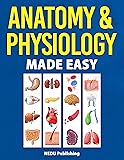Anatomy & Physiology Made Easy: An Illustrated Study Guide for Students To Easily Learn Anatomy and Physiology
amazon.com
Anatomy & Physiology Made Easy: An Illustrated Study Guide for Students To Easily Learn Anatomy and Physiology

The pulmonary veins that come from the lungs into the left atrium are still called veins, even though they are high in oxygen.
The amount of blood your heart puts out in one minute is called its cardiac output.
Physiology can be biochemical. It can include how the different molecules get inside or outside the cells, and explain how each of the tiny molecular processes happen inside the organelles, or internal structures of your cell.
Did you know your skin is the largest organ of your body?
The average person who doesn’t exercise much will easily raise their heart rate with exercise.
Arteries are any vessel that is traveling outward from the heart, regardless of what kind of blood is in it. This is why the pulmonary arteries leaving the right ventricle are called arteries, even though they are low in oxygen.
If a valve is leaky and blood flows backward when it isn’t supposed to, this is called regurgitation.
Your heart is a muscle that’s about the size of your fist. It is made from cardiac muscle cells that have what’s called autorhythmicity, which means it doesn’t take continued stimulation by any nerve to keep the heart muscle cells happily contracting away no matter what you do.